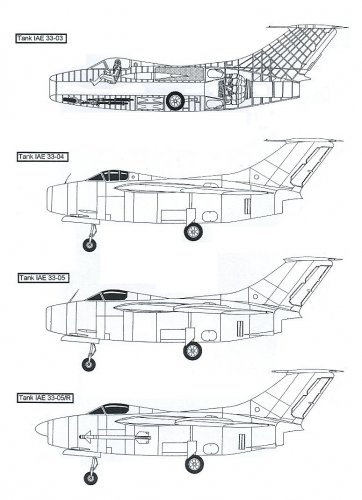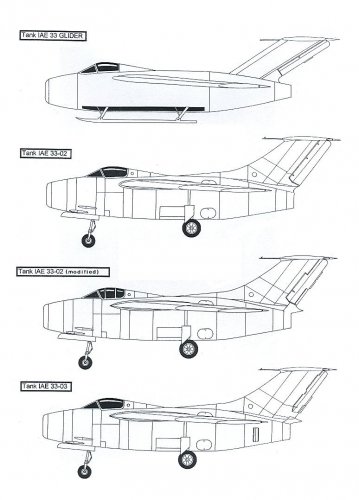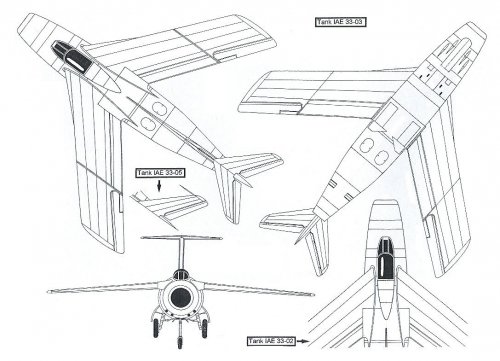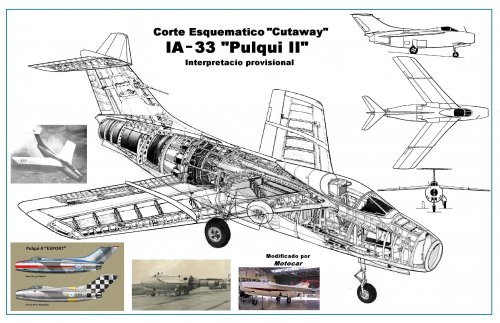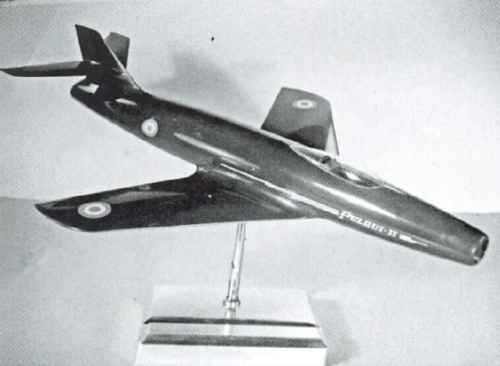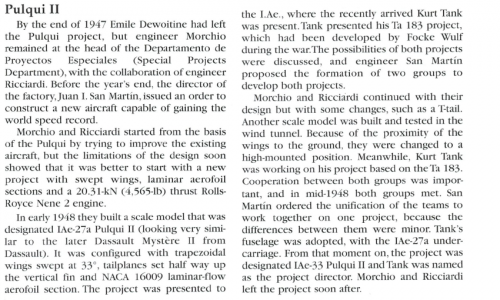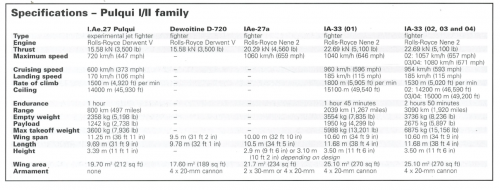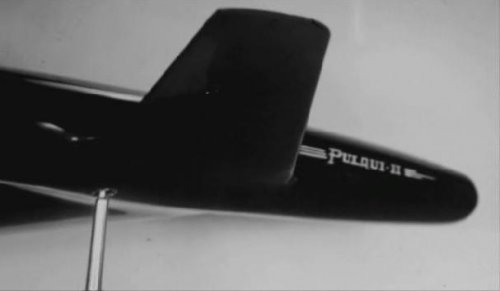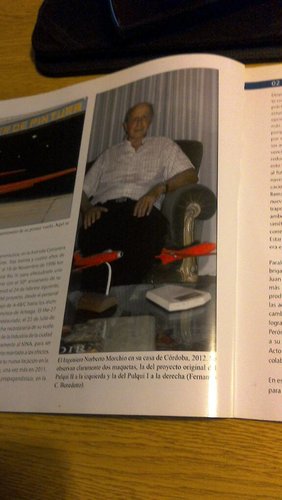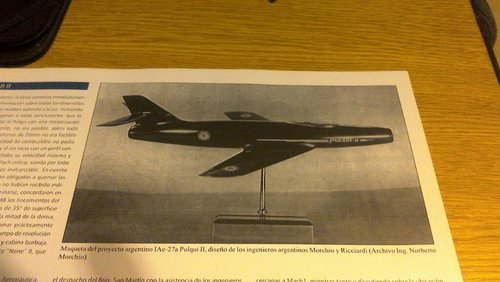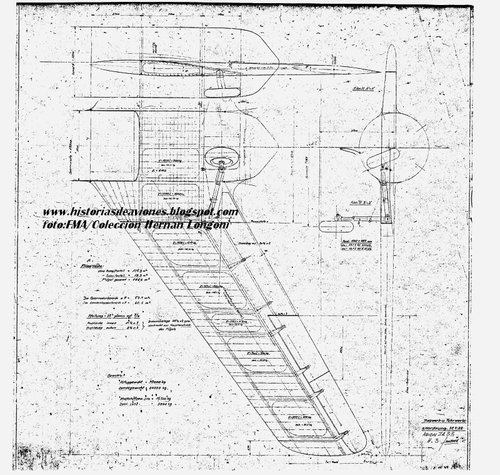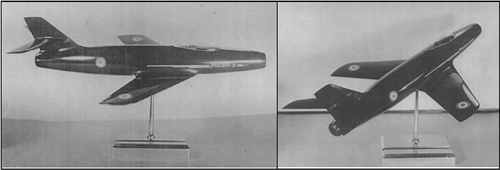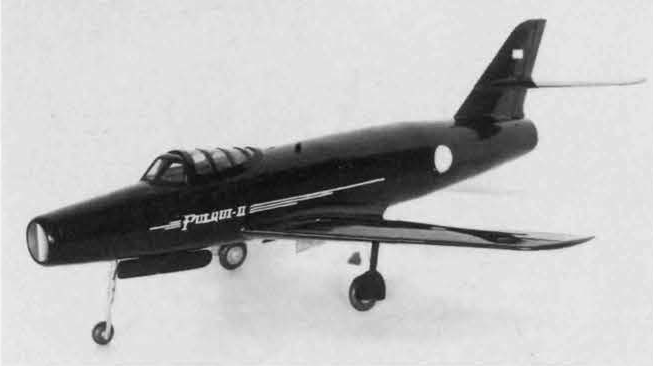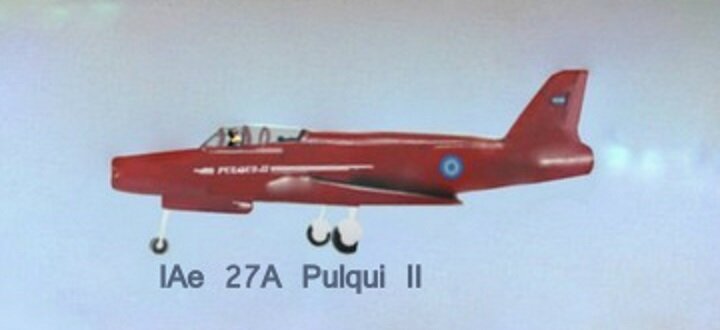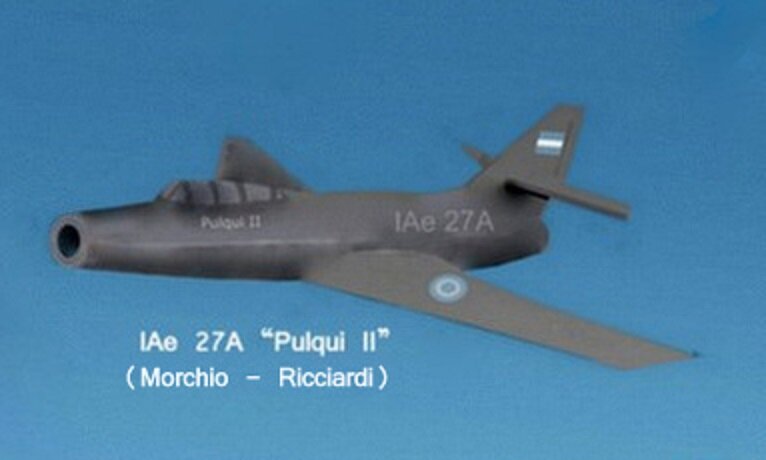You are using an out of date browser. It may not display this or other websites correctly.
You should upgrade or use an alternative browser.
You should upgrade or use an alternative browser.
IAe 27 / 31 Pulqui I and II
- Thread starter Justo Miranda
- Start date
It helps to have someone like Kurt Tank involved.
Regards,
Greg
Regards,
Greg
Retrofit
ACCESS: Top Secret
- Joined
- 21 February 2007
- Messages
- 656
- Reaction score
- 337
I think that Reimar Horten was also involved in the development of the Pulqui II's experimental glider when he arrived in Argentina, before switching back to his flying-wing designs (IAe-34, 37, 38, 41, 48, Pierniferos...).
MC72
ACCESS: Confidential
- Joined
- 16 October 2010
- Messages
- 91
- Reaction score
- 116
Tank's Pulqui-II,
if brought to the stage of production could have been measured with their natural counterparts MiG-15, F-86 Sabre, There were no shortage of potentials Buyers outside the major alliances (USA-CCCP); The Spain of General Franco (friend of Argentina) needed replacements for their old fighters; There were some who need to begins to shoot right away, like the Arab countries or........... the explosive Indian sub-continent, of the time.
These could have been possible colors of the "Export" Pulqui-II.
Saludos
MC72

if brought to the stage of production could have been measured with their natural counterparts MiG-15, F-86 Sabre, There were no shortage of potentials Buyers outside the major alliances (USA-CCCP); The Spain of General Franco (friend of Argentina) needed replacements for their old fighters; There were some who need to begins to shoot right away, like the Arab countries or........... the explosive Indian sub-continent, of the time.
These could have been possible colors of the "Export" Pulqui-II.
Saludos
MC72

Very interesting work!
It seems to me to eat questions on a combination of the channel of an air inlet and a cabin, feet of the pilot couldn't is in an air stream, whether not so?
Whether saw you these photos
http://www.mincyt.cba.gov.ar/site/fabricamilitar/images/fotos/foto231z.jpg
http://www.mincyt.cba.gov.ar/site/fabricamilitar/images/fotos/foto230z.jpg
here:
http://www.mincyt.cba.gov.ar/site/fabricamilitar/fotos/fotos009.html
Judging by a photo the nasal part has slightly other rivets of a line!
According to the panel lines can be others?
You couldn't compare Pulki II with Lavochkin La-168 and Lavochkin La-176?
http://www.aviastar.org/air/russia/la-168.php
http://www.aviastar.org/air/russia/la-176.php
There is something the general, whether a lie?
B.R. Serge
It seems to me to eat questions on a combination of the channel of an air inlet and a cabin, feet of the pilot couldn't is in an air stream, whether not so?
Whether saw you these photos
http://www.mincyt.cba.gov.ar/site/fabricamilitar/images/fotos/foto231z.jpg
http://www.mincyt.cba.gov.ar/site/fabricamilitar/images/fotos/foto230z.jpg
here:
http://www.mincyt.cba.gov.ar/site/fabricamilitar/fotos/fotos009.html
Judging by a photo the nasal part has slightly other rivets of a line!
According to the panel lines can be others?
You couldn't compare Pulki II with Lavochkin La-168 and Lavochkin La-176?
http://www.aviastar.org/air/russia/la-168.php
http://www.aviastar.org/air/russia/la-176.php
There is something the general, whether a lie?
B.R. Serge
Hammer Birchgrove
ACCESS: Top Secret
- Joined
- 13 May 2009
- Messages
- 583
- Reaction score
- 45
While I doubt Sweden (under a Social Democratic government) would sell SAAB J-29 Tunnan (or any other military aircraft) to Franco's Spain, it would probably gladly sell to India, which didn't happen.
Were the aerodynamic and the other possible issues with the Palqui II going to be solved?
Were the aerodynamic and the other possible issues with the Palqui II going to be solved?
MC72
ACCESS: Confidential
- Joined
- 16 October 2010
- Messages
- 91
- Reaction score
- 116
Clearly the air flow in the case of the Tank's Pulqui-II, goes to the sides of the cabin and not below it, with better aerodynamics.Aardvark said:Very interesting work!
It seems to me to eat questions on a combination of the channel of an air inlet and a cabin, feet of the pilot couldn't is in an air stream, whether not so?
Whether saw you these photos
http://www.mincyt.cba.gov.ar/site/fabricamilitar/images/fotos/foto231z.jpg
http://www.mincyt.cba.gov.ar/site/fabricamilitar/images/fotos/foto230z.jpg
here:
http://www.mincyt.cba.gov.ar/site/fabricamilitar/fotos/fotos009.html
Judging by a photo the nasal part has slightly other rivets of a line!
According to the panel lines can be others?
You couldn't compare Pulki II with Lavochkin La-168 and Lavochkin La-176?
http://www.aviastar.org/air/russia/la-168.php
http://www.aviastar.org/air/russia/la-176.php
There is something the general, whether a lie?
B.R. Serge

The configuration of air flow of Tank's Pulqui-II is best fit, than that used in the Ta.183 Huckebein which in turn probably comes from the Saab Tunnan; These two have more frontal area, and therefore more aerodynamic resistance.
What you mean precisely, compare Pulqui-II, with the Lavochkin La-168 and the Lavochkin La-176?
Saludos
MC-72

MC72
ACCESS: Confidential
- Joined
- 16 October 2010
- Messages
- 91
- Reaction score
- 116
Hammer Birchgrove said:While I doubt Sweden (under a Social Democratic government) would sell SAAB J-29 Tunnan (or any other military aircraft) to Franco's Spain, it would probably gladly sell to India, which didn't happen.
Were the aerodynamic and the other possible issues with the Palqui II going to be solved?
Sweden makes good airplanes! But its policy of extrict neutrality, preclude the sale of this aircraft...........a country like France more "open-minded" would have done great business with this same model.....No doubts!!
However there is a exception, the Tunnan was sold to the then "neutral" Austria, and even participates to the UN-forces for the secessionist conflict in the Congolese province of Katanga.
Hammer Birchgrove
ACCESS: Top Secret
- Joined
- 13 May 2009
- Messages
- 583
- Reaction score
- 45
This is true.MC72 said:Hammer Birchgrove said:While I doubt Sweden (under a Social Democratic government) would sell SAAB J-29 Tunnan (or any other military aircraft) to Franco's Spain, it would probably gladly sell to India, which didn't happen.
Were the aerodynamic and the other possible issues with the Palqui II going to be solved?
Sweden makes good airplanes! But its policy of extrict neutrality, preclude the sale of this aircraft...........a country like France more "open-minded" would have done great business with this same model.....No doubts!!
However there is a exception, the Tunnan was sold to the then "neutral" Austria, and even participates to the UN-forces for the secessionist conflict in the Congolese province of Katanga.
- Joined
- 28 November 2006
- Messages
- 711
- Reaction score
- 732
MC72 said:Hammer Birchgrove said:While I doubt Sweden (under a Social Democratic government) would sell SAAB J-29 Tunnan (or any other military aircraft) to Franco's Spain, it would probably gladly sell to India, which didn't happen.
Were the aerodynamic and the other possible issues with the Palqui II going to be solved?
Sweden makes good airplanes! But its policy of extrict neutrality, preclude the sale of this aircraft...........a country like France more "open-minded" would have done great business with this same model.....No doubts!!
However there is a exception, the Tunnan was sold to the then "neutral" Austria, and even participates to the UN-forces for the secessionist conflict in the Congolese province of Katanga.
It's slightly off topic discussion, but actually Sweden had never such non-export policy, to mention only the Bofors guns world-wide success, the Carl Gustaf recoilles guns and so on. As for aircraft the Swedes tried to sell them to numerous countries but made it only in few instances (Denmark, Austria, Finland in the Cold War era). You may find details at http://www.x-plane.org/home/urf/aviation/text/exports.html.
It's hard to tell about possibility of selling Swedish aircraft to Franco's Spain, only because there were no such projects or attempts. What remains certain is that in the late 1940s/early 1950s Sweden did sell Spain Bofors 40 mm anti-aircraft guns.
Best regards,
Piotr
Hammer Birchgrove
ACCESS: Top Secret
- Joined
- 13 May 2009
- Messages
- 583
- Reaction score
- 45
I stand corrected. Well, at least the 40 mm Bofors was a defensive weapon, but still. 
- Joined
- 25 June 2009
- Messages
- 14,732
- Reaction score
- 6,072
MC72 said:There were no shortage of potentials Buyers outside the major alliances (USA-CCCP); The Spain of General Franco (friend of Argentina) needed replacements for their old fighters; There were some who need to begins to shoot right away, like the Arab countries or........... the explosive Indian sub-continent, of the time.
These could have been possible colors of the "Export" Pulqui-II.
Translated from the French Aviation Magazine N°80, 15 August 1953:
The IA-33 Pulqui II, a swept-wing jet fighter designed by German engineer Kurt Tank, has been plagued with bad fortune, with the successive crash of two prototypes. Flight testing has recently resumed and has been described as especially satisfactory both in terms of maneuverability and speed — the speed of sound being attained in a dive. It is now likely that this aircraft will be produced. The United States are reportedly willing to acquire a Pulqui II in order to test it.
A Pulqui II in American colors?!? That would have been something!
- Joined
- 26 May 2006
- Messages
- 34,828
- Reaction score
- 15,709
Motocar said:I have the cutaway drawing Pulqui II
Can you send it,and thanks.
- Joined
- 28 November 2006
- Messages
- 711
- Reaction score
- 732
Re: Argentinian Unbuilt Projects - IA-27a Pulqui II
In the International Air Power Review Vol. 25 there is an article on Argentinian jet projects. Amongst others it briefly mentions what was designated IAe-27a Pulqui II and what was an intermediate phase of development between IAe-27 Pulqui I by Dewoitine and IAe-33 Pulqui II by Tank. Interestingly IAe-27a was designed by Argentinian (or Italian) engineers who had previously worked with Dewoitine on IAe-27.
Here you have cutouts from the IAPR article containing a photo of IAe-27a's modell as well as what the article says on the project and a table with specifications of all members of the Pulqui family, incl. the IAe-27a.
Regards,
Piotr
In the International Air Power Review Vol. 25 there is an article on Argentinian jet projects. Amongst others it briefly mentions what was designated IAe-27a Pulqui II and what was an intermediate phase of development between IAe-27 Pulqui I by Dewoitine and IAe-33 Pulqui II by Tank. Interestingly IAe-27a was designed by Argentinian (or Italian) engineers who had previously worked with Dewoitine on IAe-27.
Here you have cutouts from the IAPR article containing a photo of IAe-27a's modell as well as what the article says on the project and a table with specifications of all members of the Pulqui family, incl. the IAe-27a.
Regards,
Piotr
Attachments
- Joined
- 28 November 2006
- Messages
- 711
- Reaction score
- 732
kitnut617 said:If that is a Pulqui II, what are these
https://www.secretprojects.co.uk/forum/index.php?action=dlattach;topic=211.0;attach=576918
What the IAPR article says may be understood that original Pulqui II was IAe-27a. After Kurt Tank took over the design the Pulqui II designation was retained but the numerical one was changed from '27a' to '33'.
So apparently there were two Pulqui IIs: IAe-27a and IAe-33.
Piotr
- Joined
- 28 November 2006
- Messages
- 711
- Reaction score
- 732
- Joined
- 28 November 2006
- Messages
- 711
- Reaction score
- 732
Again on the IAe-27a.
This time two photos of pages from an Argentinian magazine, in first of which you may see Mr Norberto Morchio in his home in Cordoba in 2012 beside models of 'the original design' of Pulqui II and Pulqui I and in the other - model of the IAe-27a (the same as above). Perhaps anyone can tell what magazine the photos come from?
In addition to that: from http://historiasdeaviones.blogspot.com/2013/11/la-genesis-de-las-flechas.html a drawing of the wing and undercarriage of the first prototype of IA-33 (you may see the "IA-33" in the right-lower corner of the drawing). It looks quite interesting as it clearly depict a mid-wing aircraft, not the high-wing (IA-33 as built). So I suspect that this was to be an intermediate phase of the design between Morchio-Ricciardi's design and that of Tank. Bearing in mind a remark from the article in the IAPR (https://www.secretprojects.co.uk/threads/argentinian-unbuilt-projects.211/post-347027) that "Tank's fuselage was adopted with the IAe-27a undercarriage", what may be seen in the drawing is the undercarriage arrangement from the Morchio-Ricciardi project. It may be also an indication that their project was in fact mid-wing rather than low-wing.
Btw does anybody have the drawing with higher resolution?
Piotr
This time two photos of pages from an Argentinian magazine, in first of which you may see Mr Norberto Morchio in his home in Cordoba in 2012 beside models of 'the original design' of Pulqui II and Pulqui I and in the other - model of the IAe-27a (the same as above). Perhaps anyone can tell what magazine the photos come from?
In addition to that: from http://historiasdeaviones.blogspot.com/2013/11/la-genesis-de-las-flechas.html a drawing of the wing and undercarriage of the first prototype of IA-33 (you may see the "IA-33" in the right-lower corner of the drawing). It looks quite interesting as it clearly depict a mid-wing aircraft, not the high-wing (IA-33 as built). So I suspect that this was to be an intermediate phase of the design between Morchio-Ricciardi's design and that of Tank. Bearing in mind a remark from the article in the IAPR (https://www.secretprojects.co.uk/threads/argentinian-unbuilt-projects.211/post-347027) that "Tank's fuselage was adopted with the IAe-27a undercarriage", what may be seen in the drawing is the undercarriage arrangement from the Morchio-Ricciardi project. It may be also an indication that their project was in fact mid-wing rather than low-wing.
Btw does anybody have the drawing with higher resolution?
Piotr
Attachments
Last edited:
- Joined
- 28 November 2006
- Messages
- 711
- Reaction score
- 732
Yet another photo of the IA-27a model. Source: "Proyecto Pulqui II. Una sociología histórica de la innovación tecnológica en tiempos de Perón" by Alejandro Artopoulos. The book (actually a thesis) may be found there: https://www.scribd.com/document/374815146/Historia-del-Desarrollo-Auge-y-Caida-del-Pulqui-II
BR
Piotr
BR
Piotr
Attachments
blockhaj
Swedish "want to be" aviation specialist
- Joined
- 9 February 2017
- Messages
- 397
- Reaction score
- 486
This is a repost from this thread (plus this) but i thought i would post it here as it is relevant to the topic of the Pulqui II. I looked into the Pulqui II prototype names and found this: https://archive.org/stream/alan_147/SAFO 144_djvu.txt
If this text is correct then most books and sources about the Pulqui II are incorrect, with only 4 complete prototypes being made.
If this text is correct then most books and sources about the Pulqui II are incorrect, with only 4 complete prototypes being made.
- E-1- first prototype, armed with four 20 mm MG-151 cannons. First flight: June 16, 1950. Crashed: May 1951.
- E-2 - second prototype, initially unarmed and planned for static tests but was later modified to become flight worthy when the E-3 crashed in 1952. The modification was done in 1953 and included: first fitting of the planned armament of four 20 mm HS 804 cannons, one wing fence per wing, four trakes on the tail, air brakes, increased fuel capacity from 2,000 to 3,000 liters (as per E-3), strengthened landing gear (as per E-3), in-flight adjustable rudder (as per E-3). This modification is what i believe most people call "prototype 04" and the "prototype 02m" (modified), etc. Crashed 1956.
- E-3 - third prototype, unarmed. Modifications from E-1: increased fuel capacity (2,000 to 3,000 liters), strengthened landing gear, in-flight adjustable rudder. First flight: early 1952. Crashed october 1952.
- E-4 - fourth prototype, never completed with parts going into the E-5.
- E-5 - fifth prototype, completed in 1959 using parts from E-4 and E-6 as the final Pulqui II. It is called "Pulqui IIe" at times but was equal to the final E-2 but without armament. First flight: May 1960. Given to "Museo Nacional de Aeronáutica de Argentina" at the end of 1960.
- E-6 - sixth prototype, never completed with parts going into the E-5.
blockhaj
Swedish "want to be" aviation specialist
- Joined
- 9 February 2017
- Messages
- 397
- Reaction score
- 486
Lovely. Will translate it properly when i get home.LAS FLECHAS ARGENTINAS – DESARROLLO E HISTORIA DE LOS PULQUI I Y PULQUI II DE LA FABRICA MILITAR DE AVIONES
By Atilio Marino (Avialatina Group)
Erdosain
ACCESS: Secret
- Joined
- 10 March 2020
- Messages
- 476
- Reaction score
- 1,956
- Joined
- 6 September 2006
- Messages
- 4,829
- Reaction score
- 9,424
I don't think we've had this before, Emile Dewotine's proposal for the Pulqui II, which was turned down by the Argentines in favour Kurt Tank's designs.
To be fully honest (if not brutal): I can readily understand why they went for K. Tank design. Of course hindsight is alway 20/20.
Erdosain
ACCESS: Secret
- Joined
- 10 March 2020
- Messages
- 476
- Reaction score
- 1,956
I don't think we've had this before, Emile Dewotine's proposal for the Pulqui II, which was turned down by the Argentines in favour Kurt Tank's designs.
Actually, the best of both projects was taken for the I.Ae.33 Pulqui II.
Later, the Argentine designers in charge of this project decided to leave the FMA. It seems to be because they felt displaced by the Germans and they did not share their information with their Argentine colleagues:

Erdosain
ACCESS: Secret
- Joined
- 10 March 2020
- Messages
- 476
- Reaction score
- 1,956
Why did the Pulqui II not reach mass production? A historical sociology of technological innovation in the times of Perón. (PDF)
Last edited:
Erdosain
ACCESS: Secret
- Joined
- 10 March 2020
- Messages
- 476
- Reaction score
- 1,956
The History of the Pulqui

 agendarweb.com.ar
agendarweb.com.ar
 agendarweb.com.ar
agendarweb.com.ar

 agendarweb.com.ar
agendarweb.com.ar

 agendarweb.com.ar
agendarweb.com.ar

 agendarweb.com.ar
agendarweb.com.ar


La Historia del Pulqui - 1° | AgendAR
La historia del Pulqui, una hazaña tecnológica argentina de más de 60 años atrás. Y sus enseñanzas para otra, más reciente, el reactor nuclear CAREM.
La Historia del Pulqui - 2° | AgendAR
Una de las dos últimas fotos de Antoine de Saint Exupéry antes de subirse al Lockheed P-38 aerofotográfico en que fue abatido por el FW-190 de Horst Rippert, un as alemán con 28 derribos que se había hecho piloto por inspiración de los libros de “Saint Ex”. “De haber sabido que era él, no...

La Historia del Pulqui - 3ª | AgendAR
Hace algo más de un año publicamos una crónica en 5 capítulos de la historia del Pulqui, escrita por Daniel Arias. De una hazaña tecnológica argentina de más de 60 años atrás, y sus enseñanzas para otra, más reciente, el reactor nuclear CAREM. Volvemos a hacerlo, porque viene un nuevo gobierno...

La Historia del Pulqui – 4° | AgendAR
El teniente Jorge Conan Doyle divertido por tener que volar acostado en el futuro interceptor supersónico Ia-37 de Reimar Horten. Para el alemán, la aerodinámica mandaba sobre todo. Hace algo más de un año publicamos una crónica en 5 capítulos de la historia del Pulqui, escrita por Daniel Arias...

La Historia del Pulqui – 5° | AgendAR
Ia-35 Huanqueros en recta final de aterrizaje. Único avión de “la época de oro” del IAME que se fabricó en cierta cantidad (41 unidades). Hace algo más de un año publicamos una crónica en 5 capítulos de la historia del Pulqui, escrita por Daniel Arias. De una hazaña tecnológica argentina de más...

Erdosain
ACCESS: Secret
- Joined
- 10 March 2020
- Messages
- 476
- Reaction score
- 1,956
View: https://twitter.com/HoracioClaria/status/1425552060175556608?ref_src=twsrc%5Etfw%7Ctwcamp%5Etweetembed%7Ctwterm%5E1425552060175556608%7Ctwgr%5E%7Ctwcon%5Es1_&ref_url=https%3A%2F%2Fwww.zona-militar.com%2Fforos%2Fthreads%2Fa-60-aC3B1os-del-primer-vuelo-del-pulqui.7193%2Fpage-2
View: https://twitter.com/PucaraD/status/1425523344212959232?ref_src=twsrc%5Etfw%7Ctwcamp%5Etweetembed%7Ctwterm%5E1425523344212959232%7Ctwgr%5E%7Ctwcon%5Es1_&ref_url=https%3A%2F%2Fwww.zona-militar.com%2Fforos%2Fthreads%2Fa-60-aC3B1os-del-primer-vuelo-del-pulqui.7193%2Fpage-2
View: https://twitter.com/PucaraD/status/1425523344212959232?ref_src=twsrc%5Etfw%7Ctwcamp%5Etweetembed%7Ctwterm%5E1425523344212959232%7Ctwgr%5E%7Ctwcon%5Es1_&ref_url=https%3A%2F%2Fwww.zona-militar.com%2Fforos%2Fthreads%2Fa-60-aC3B1os-del-primer-vuelo-del-pulqui.7193%2Fpage-2
Deltafan
ACCESS: Top Secret
- Joined
- 8 May 2006
- Messages
- 1,695
- Reaction score
- 2,301
I don't think we've had this before, Emile Dewotine's proposal for the Pulqui II, which was turned down by the Argentines in favour Kurt Tank's designs.
Thanks a lot for your photos.I don't think we've had this before, Emile Dewotine's proposal for the Pulqui II, which was turned down by the Argentines in favour Kurt Tank's designs.
Actually, the best of both projects was taken for the I.Ae.33 Pulqui II.
Later, the Argentine designers in charge of this project decided to leave the FMA. It seems to be because they felt displaced by the Germans and they did not share their information with their Argentine colleagues:
What are your sources ?
On the French websites https://aviationsmilitaires.net/v3/forum/reste-du-monde-26/topic/fma-iae-27-pulqui-2833/?page=1
They gave, some years ago, this link :

F.M.A. Fábrica Militar de Aviones/Military Aircraft Factory
The I.Ae. 27 Pulqui I was an Argentine jet fighter designed at the "Instituto Aerotecnico" (AeroTechnical Institute) in 1946. Only one prototype was completed; unsatisfactory performance led to the...
www.militariarg.com
with these two "photos" :
Attachments
Last edited:
Erdosain
ACCESS: Secret
- Joined
- 10 March 2020
- Messages
- 476
- Reaction score
- 1,956
En Argentina hay muchos libros publicados sobre las FMA y Pulqui II, e información en sitios web en español de autores locales que tuvieron acceso directo a la información y documentos:No creo que hayamos tenido esto antes, la propuesta de Emile Dewotine para el Pulqui II, que fue rechazada por los argentinos a favor de los diseños de Kurt Tank.Muchas gracias por tus fotos.No creo que hayamos tenido esto antes, la propuesta de Emile Dewotine para el Pulqui II, que fue rechazada por los argentinos a favor de los diseños de Kurt Tank.
En realidad, lo mejor de ambos proyectos se lo llevó el I.Ae.33 Pulqui II.
Posteriormente, los diseñadores argentinos a cargo de este proyecto decidieron dejar la FMA. Parece ser porque se sintieron desplazados por los alemanes y no compartieron su información con sus colegas argentinos:
¿Cuáles son tus fuentes?
En los sitios web franceses https://aviationsmilitaires.net/v3/forum/reste-du-monde-26/topic/fma-iae-27-pulqui-2833/?page=1
Ellos dieron, hace algunos años, este enlace:
con estas dos "fotos" :
http://www.militariarg.com/uploads/4/2/2/1/4221080/1381952436.jpg
http://www.militariarg.com/uploads/4/2/2/1/4221080/9281332_orig.jpg

Nace el IAe-27 Pulqui.
Dos visionarios: De la Colina y San Martin. Por Hernan Longoni Este monoreactor monoplaza fue el primero de su tipo en ser diseñado en lat...

La genesis de las flechas
Por Hernan Longoni “ A Los Ingenieros Morchio, Ricciardi, Cardeilac, Kurt Tank, Otto Behrens, Osvaldo Weiss y Vedania Mannuwal. ” El ...
Last edited:
Erdosain
ACCESS: Secret
- Joined
- 10 March 2020
- Messages
- 476
- Reaction score
- 1,956
Erdosain
ACCESS: Secret
- Joined
- 10 March 2020
- Messages
- 476
- Reaction score
- 1,956
This is one of the best books about Pulqui I and III don't think we've had this before, Emile Dewotine's proposal for the Pulqui II, which was turned down by the Argentines in favour Kurt Tank's designs.Thanks a lot for your photos.I don't think we've had this before, Emile Dewotine's proposal for the Pulqui II, which was turned down by the Argentines in favour Kurt Tank's designs.
Actually, the best of both projects was taken for the I.Ae.33 Pulqui II.
Later, the Argentine designers in charge of this project decided to leave the FMA. It seems to be because they felt displaced by the Germans and they did not share their information with their Argentine colleagues:
What are your sources ?
On the French websites https://aviationsmilitaires.net/v3/forum/reste-du-monde-26/topic/fma-iae-27-pulqui-2833/?page=1
They gave, some years ago, this link :

F.M.A. Fábrica Militar de Aviones/Military Aircraft Factory
The I.Ae. 27 Pulqui I was an Argentine jet fighter designed at the "Instituto Aerotecnico" (AeroTechnical Institute) in 1946. Only one prototype was completed; unsatisfactory performance led to the...www.militariarg.com
with these two "photos" :
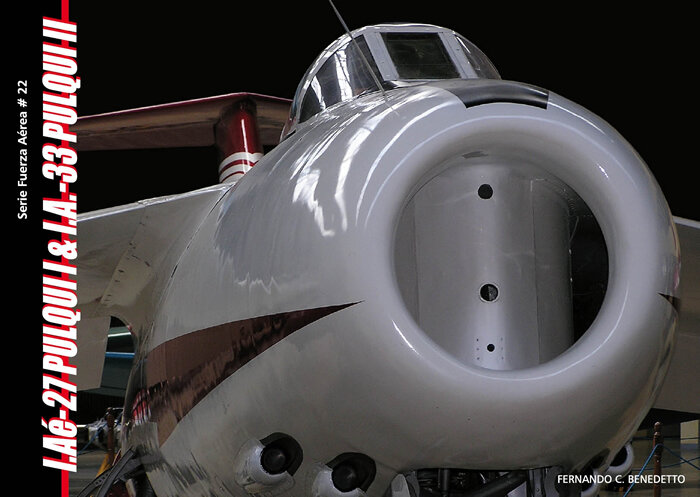
Erdosain
ACCESS: Secret
- Joined
- 10 March 2020
- Messages
- 476
- Reaction score
- 1,956

Presentación del Pulqui II en el Aeroparque (1951) - Aviones en Argentina
 avionesenargentina.com
avionesenargentina.com
Similar threads
-
Critique of 1945 German aircraft designs - where were the mistakes?
- Started by Avimimus
- Replies: 35
-
-
-
Fairchild XNQ-1 and YT-31 basic trainers
- Started by frank
- Replies: 8
-
Renard Fighter Projects and Prototypes
- Started by Justo Miranda
- Replies: 14

